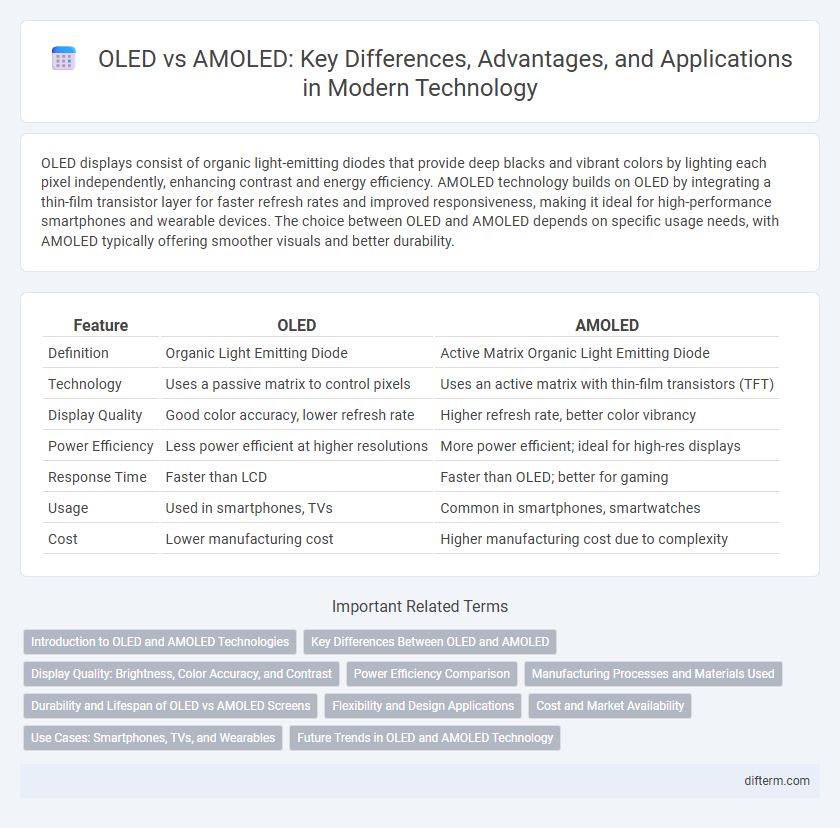OLED displays consist of organic light-emitting diodes that provide deep blacks and vibrant colors by lighting each pixel independently, enhancing contrast and energy efficiency. AMOLED technology builds on OLED by integrating a thin-film transistor layer for faster refresh rates and improved responsiveness, making it ideal for high-performance smartphones and wearable devices. The choice between OLED and AMOLED depends on specific usage needs, with AMOLED typically offering smoother visuals and better durability.
Table of Comparison
| Feature | OLED | AMOLED |
|---|---|---|
| Definition | Organic Light Emitting Diode | Active Matrix Organic Light Emitting Diode |
| Technology | Uses a passive matrix to control pixels | Uses an active matrix with thin-film transistors (TFT) |
| Display Quality | Good color accuracy, lower refresh rate | Higher refresh rate, better color vibrancy |
| Power Efficiency | Less power efficient at higher resolutions | More power efficient; ideal for high-res displays |
| Response Time | Faster than LCD | Faster than OLED; better for gaming |
| Usage | Used in smartphones, TVs | Common in smartphones, smartwatches |
| Cost | Lower manufacturing cost | Higher manufacturing cost due to complexity |
Introduction to OLED and AMOLED Technologies
OLED (Organic Light Emitting Diode) technology uses organic compounds that emit light when an electric current passes through them, enabling thinner, flexible, and more energy-efficient displays compared to traditional LCDs. AMOLED (Active Matrix OLED) integrates an active matrix of thin-film transistors to control each pixel individually, delivering faster refresh rates and higher contrast ratios ideal for smartphones and high-resolution screens. Both technologies offer superior color accuracy and deeper blacks, with AMOLED providing enhanced responsiveness and power efficiency in dynamic visual applications.
Key Differences Between OLED and AMOLED
OLED (Organic Light Emitting Diode) displays use a single layer of organic material that emits light when an electric current passes through, offering excellent color accuracy and contrast. AMOLED (Active Matrix OLED) incorporates an active matrix thin-film transistor (TFT) array that controls pixels individually, resulting in faster refresh rates, improved energy efficiency, and better performance in high-resolution displays. Key differences include AMOLED's superior responsiveness and power management, making it the preferred technology for smartphones and wearables compared to traditional OLED screens.
Display Quality: Brightness, Color Accuracy, and Contrast
AMOLED displays typically offer higher brightness and better contrast ratios than standard OLEDs due to their integrated active matrix technology, which controls individual pixels more precisely. The color accuracy in AMOLED screens is often superior, delivering more vibrant and true-to-life colors, especially in dynamic lighting conditions. Enhanced black levels and deeper contrast result from AMOLED's ability to completely shut off pixels, making it ideal for high-quality display performance in smartphones and TVs.
Power Efficiency Comparison
OLED displays consume less power when displaying darker images due to their self-emissive pixels, which turn off completely to show true blacks, resulting in significant energy savings. AMOLED technology enhances this efficiency by integrating a thin-film transistor layer directly onto the OLED panel, allowing for faster refresh rates and more precise pixel control that reduce overall power consumption. In scenarios with high brightness and colorful content, AMOLED's optimized pixel management often outperforms traditional OLED panels in maintaining lower power usage.
Manufacturing Processes and Materials Used
OLED displays utilize simple organic light-emitting diodes composed of small-molecule or polymer organic compounds deposited through vacuum thermal evaporation or solution-based processes. AMOLED technology integrates a thin-film transistor (TFT) array onto the OLED panel, employing more complex manufacturing steps including photolithography and patterning to enable active matrix control. Materials used in AMOLED include high-purity organic layers combined with polysilicon TFT substrates, enhancing display responsiveness and allowing finer pixel control compared to passive-matrix OLED counterparts.
Durability and Lifespan of OLED vs AMOLED Screens
OLED and AMOLED screens differ in durability and lifespan due to their pixel structure and refresh mechanisms. AMOLED displays, incorporating an active matrix of thin-film transistors (TFTs), offer better power efficiency and longer lifespan by selectively activating pixels, reducing burn-in risks compared to passive OLED technology. Studies show AMOLED panels typically maintain brightness and color accuracy over 30,000 to 50,000 hours, outperforming traditional OLEDs which degrade faster under constant use.
Flexibility and Design Applications
AMOLED displays offer superior flexibility compared to traditional OLED screens due to their integration of thin-film transistor (TFT) backplanes, enabling bendable and foldable device designs. The enhanced flexibility of AMOLED technology supports innovative applications in wearable devices, curved smartphones, and rollable televisions. This adaptability drives advancements in sleek, lightweight electronics with seamless, edge-to-edge displays.
Cost and Market Availability
OLED displays generally cost less to produce than AMOLED screens due to simpler manufacturing processes, making them more accessible in budget devices. AMOLED technology, featuring integrated touch sensors and superior color accuracy, commands a higher price but dominates premium smartphones and wearable markets. Market availability of OLED panels spans various electronics, while AMOLED is predominantly found in high-end devices from leading brands like Samsung and OnePlus.
Use Cases: Smartphones, TVs, and Wearables
OLED technology offers exceptional color accuracy and contrast, making it ideal for premium smartphones and high-end TVs where vibrant visuals are critical. AMOLED displays enhance this by incorporating an active matrix, providing faster refresh rates and better energy efficiency, which is essential for wearables and mobile devices demanding longer battery life. In TVs, OLED excels in delivering deep blacks and wide viewing angles, while AMOLED's rapid response times benefit dynamic smartphone interfaces and smartwatches.
Future Trends in OLED and AMOLED Technology
Future trends in OLED and AMOLED technology emphasize enhanced flexibility, improved energy efficiency, and higher resolution displays to meet growing demands for advanced smartphones, wearable devices, and foldable screens. Innovations like microLED integration and advanced quantum dot enhancements are poised to extend the lifespan and brightness of OLED and AMOLED panels. Research into sustainable manufacturing processes and flexible substrate materials continues to drive the commercialization of next-generation display technologies.
OLED vs AMOLED Infographic

 difterm.com
difterm.com